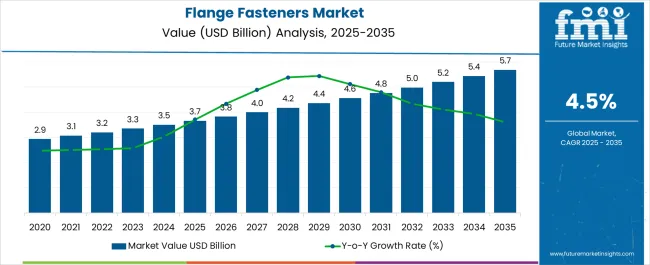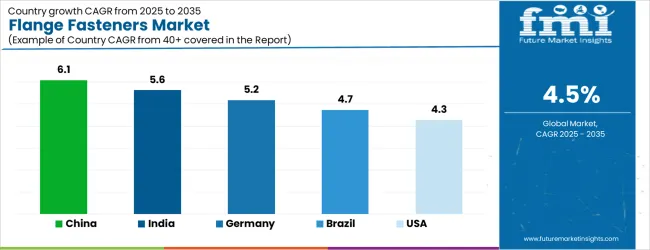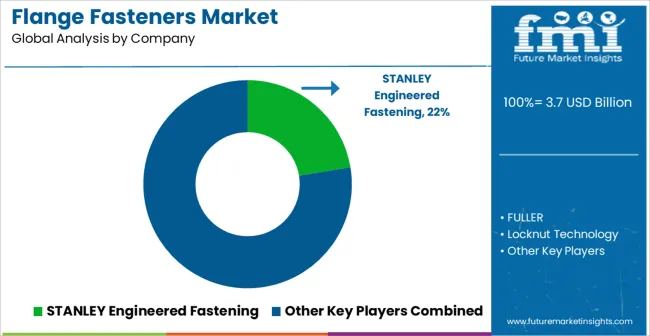The Flange Fasteners Market is estimated to be valued at USD 3.7 billion in 2025 and is projected to reach USD 5.7 billion by 2035, registering a compound annual growth rate (CAGR) of 4.5% over the forecast period.

| Metric | Value |
|---|---|
| Flange Fasteners Market Estimated Value in (2025 E) | USD 3.7 billion |
| Flange Fasteners Market Forecast Value in (2035 F) | USD 5.7 billion |
| Forecast CAGR (2025 to 2035) | 4.5% |
The Flange Fasteners market is experiencing steady growth driven by the rising demand for high-performance fastening solutions across automotive, industrial, and infrastructure sectors. The future outlook for this market is shaped by increasing adoption of durable and corrosion-resistant materials in critical applications, along with advancements in manufacturing technologies. Growth is further supported by the automotive industry's continuous expansion, where fasteners are essential for assembly efficiency and structural integrity.
The market is also being propelled by the need for high-strength and reliable fastening solutions in industrial machinery, construction, and energy sectors. Innovations in materials and coatings, combined with improvements in design and precision engineering, are enhancing product performance, reliability, and lifespan.
Additionally, regulatory standards for safety and quality in engineering applications are encouraging the use of premium-grade fasteners, creating further opportunities for growth As industries prioritize operational safety, efficiency, and durability, the demand for advanced flange fasteners is expected to continue rising across both established and emerging markets.
The flange fasteners market is segmented by material type, type, end use, and geographic regions. By material type, flange fasteners market is divided into Stainless Steel, Cast Iron, and Others (Composites, Alloys). In terms of type, flange fasteners market is classified into Nut, Bolts, Screws, Grub Screws, and Others (Rivets, Socket Cap Screws, etc.). Based on end use, flange fasteners market is segmented into Automotive, Chemical, Oil & Gas, Energy, Pharmaceutical, Defense & Aerospace, Construction, and Food & Beverage. Regionally, the flange fasteners industry is classified into North America, Latin America, Western Europe, Eastern Europe, Balkan & Baltic Countries, Russia & Belarus, Central Asia, East Asia, South Asia & Pacific, and the Middle East & Africa.

The stainless steel material type segment is projected to hold 45.00% of the Flange Fasteners market revenue share in 2025, making it the leading material type. The growth of this segment is attributed to the superior corrosion resistance, mechanical strength, and durability offered by stainless steel fasteners.
These properties ensure reliable performance in harsh environmental conditions and high-stress applications, which are common in automotive, industrial, and construction sectors. The segment has been further strengthened by innovations in stainless steel alloys and surface treatments, which enhance longevity and reduce maintenance costs.
The widespread acceptance of stainless steel fasteners is also driven by regulatory requirements for quality and safety, along with industry preferences for long-lasting and dependable components This has solidified stainless steel as the preferred material choice for critical applications and has contributed significantly to the segment's market dominance.

The nut type segment is expected to account for 35.00% of the Flange Fasteners market revenue share in 2025, establishing it as the leading fastener type. This segment’s growth has been driven by its essential role in providing secure and stable connections in machinery, vehicles, and structural assemblies.
Nuts offer versatility in assembly processes, compatibility with various bolt sizes, and ease of installation and removal, which enhance operational efficiency. The segment’s expansion is further supported by the adoption of high-precision manufacturing techniques, which ensure consistent quality and reliability in performance.
Additionally, the increasing demand for fastening solutions that can withstand high mechanical stress and vibration has reinforced the preference for nut-based fasteners The combination of durability, efficiency, and adaptability has strengthened the prominence of the nut segment in the overall market.

The automotive end-use industry segment is projected to hold 25.00% of the Flange Fasteners market revenue share in 2025, making it the leading end-use segment. The growth of this segment is influenced by the increasing production of vehicles worldwide, where flange fasteners play a critical role in ensuring structural integrity and assembly precision.
Automotive applications require high-strength, corrosion-resistant fasteners capable of enduring vibrations, temperature variations, and mechanical stress. The adoption of stainless steel and other premium materials has enhanced the reliability and durability of fasteners in automotive assemblies.
Additionally, the growing emphasis on vehicle safety, fuel efficiency, and lightweight components has prompted the integration of advanced fastening solutions in design and manufacturing processes The automotive sector’s continuous innovation and expansion are expected to sustain the high demand for flange fasteners, reinforcing the segment’s leading position in the market.
Flange fasteners are clamping devices for the fixation of flanges to each other on a pipeline in the global market. The overall flange fasteners consist of bolts and nuts which are used for the fastening of flanges on a pipeline or equipment.
The continuous development of the EPC (Engineering, Procurement, and Construction) companies among all the key regions and countries is estimated to be one of the most prominent drivers for the global flange fasteners market. Fluid pipelines are considered as the primary unit of any equipment, and the flange fasteners are the set of parts to connect the flanges of the several types of equipment and other tools with each other.
The flange fastening devices include nuts, bolts, washers, rivets, threaded rods, grub screws, etc. Some of the most important functions of flange fasteners are to fix the flanges of different equipment and then hold them while the system is in operation. Most importantly, when the system is under full load the flange fastener should be able to handle the pressure and stress.
The manufacturers in the global rail fastener market must strictly adhere the production standards as the safety of any system will always depend on the type and the strength of the flange fasteners. There several types of flange fasteners available in the global market, which vary according to the application, size, weight capacity and material of construction.
The increasing industrial infrastructure, as well as the maintenance & inspection of the existing systems, is projected to be one of the most opportunistic driving factors for the global flange fasteners market over the forthcoming years.

| Country | CAGR |
|---|---|
| China | 6.1% |
| India | 5.6% |
| Germany | 5.2% |
| Brazil | 4.7% |
| USA | 4.3% |
| UK | 3.8% |
| Japan | 3.4% |
The Flange Fasteners Market is expected to register a CAGR of 4.5% during the forecast period, exhibiting varied country level momentum. China leads with the highest CAGR of 6.1%, followed by India at 5.6%. Developed markets such as Germany, France, and the UK continue to expand steadily, while the USA is likely to grow at consistent rates. Japan posts the lowest CAGR at 3.4%, yet still underscores a broadly positive trajectory for the global Flange Fasteners Market. In 2024, Germany held a dominant revenue in the Western Europe market and is expected to grow with a CAGR of 5.2%. The USA Flange Fasteners Market is estimated to be valued at USD 1.3 billion in 2025 and is anticipated to reach a valuation of USD 1.3 billion by 2035. Sales are projected to rise at a CAGR of 0.0% over the forecast period between 2025 and 2035. While Japan and South Korea markets are estimated to be valued at USD 189.1 million and USD 94.1 million respectively in 2025.

| Item | Value |
|---|---|
| Quantitative Units | USD 3.7 Billion |
| Material Type | Stainless Steel, Cast Iron, and Others (Composites, Alloys) |
| Type | Nut, Bolts, Screws, Grub Screws, and Others (Rivets, Socket Cap Screws, etc.) |
| End Use | Automotive, Chemical, Oil & Gas, Energy, Pharmaceutical, Defense & Aerospace, Construction, and Food & Beverage |
| Regions Covered | North America, Europe, Asia-Pacific, Latin America, Middle East & Africa |
| Country Covered | United States, Canada, Germany, France, United Kingdom, China, Japan, India, Brazil, South Africa |
| Key Companies Profiled | STANLEY Engineered Fastening, FULLER, Locknut Technology, Ramco Specialties, Wilhelm Bollhoff GmbH und Co. KG, Jergens Inc., Jeng Bright International Corporation, TE-CO, Infasco, KMT Fasteners, RAY FU, Staytite Ltd, K.M Steel India, and Jignesh Steel |
The global flange fasteners market is estimated to be valued at USD 3.7 billion in 2025.
The market size for the flange fasteners market is projected to reach USD 5.7 billion by 2035.
The flange fasteners market is expected to grow at a 4.5% CAGR between 2025 and 2035.
The key product types in flange fasteners market are stainless steel, cast iron and others (composites, alloys).
In terms of type, nut segment to command 35.0% share in the flange fasteners market in 2025.






Our Research Products

The "Full Research Suite" delivers actionable market intel, deep dives on markets or technologies, so clients act faster, cut risk, and unlock growth.

The Leaderboard benchmarks and ranks top vendors, classifying them as Established Leaders, Leading Challengers, or Disruptors & Challengers.

Locates where complements amplify value and substitutes erode it, forecasting net impact by horizon

We deliver granular, decision-grade intel: market sizing, 5-year forecasts, pricing, adoption, usage, revenue, and operational KPIs—plus competitor tracking, regulation, and value chains—across 60 countries broadly.

Spot the shifts before they hit your P&L. We track inflection points, adoption curves, pricing moves, and ecosystem plays to show where demand is heading, why it is changing, and what to do next across high-growth markets and disruptive tech

Real-time reads of user behavior. We track shifting priorities, perceptions of today’s and next-gen services, and provider experience, then pace how fast tech moves from trial to adoption, blending buyer, consumer, and channel inputs with social signals (#WhySwitch, #UX).

Partner with our analyst team to build a custom report designed around your business priorities. From analysing market trends to assessing competitors or crafting bespoke datasets, we tailor insights to your needs.
Supplier Intelligence
Discovery & Profiling
Capacity & Footprint
Performance & Risk
Compliance & Governance
Commercial Readiness
Who Supplies Whom
Scorecards & Shortlists
Playbooks & Docs
Category Intelligence
Definition & Scope
Demand & Use Cases
Cost Drivers
Market Structure
Supply Chain Map
Trade & Policy
Operating Norms
Deliverables
Buyer Intelligence
Account Basics
Spend & Scope
Procurement Model
Vendor Requirements
Terms & Policies
Entry Strategy
Pain Points & Triggers
Outputs
Pricing Analysis
Benchmarks
Trends
Should-Cost
Indexation
Landed Cost
Commercial Terms
Deliverables
Brand Analysis
Positioning & Value Prop
Share & Presence
Customer Evidence
Go-to-Market
Digital & Reputation
Compliance & Trust
KPIs & Gaps
Outputs
Full Research Suite comprises of:
Market outlook & trends analysis
Interviews & case studies
Strategic recommendations
Vendor profiles & capabilities analysis
5-year forecasts
8 regions and 60+ country-level data splits
Market segment data splits
12 months of continuous data updates
DELIVERED AS:
PDF EXCEL ONLINE
Flanges Market Size and Share Forecast Outlook 2025 to 2035
Pipe Flange Market Analysis by Material Type, Facing, End-Use Industry, and Region through 2035
Rail Fasteners Market
Cable Flange Market
Marine Fasteners Market
Plastic Fasteners Market Analysis by Product Type, End Use, and Region Forecast Through 2035
Automotive Fasteners Market Growth -Trends & Forecast 2025 to 2035
Vacuum Fiber Feedthrough Flanges Market Size and Share Forecast Outlook 2025 to 2035
High-vacuum Fiber Feedthrough Flanges Market Size and Share Forecast Outlook 2025 to 2035

Thank you!
You will receive an email from our Business Development Manager. Please be sure to check your SPAM/JUNK folder too.
Chat With
MaRIA